Analysis of Business Law: Consumer Protection and Contractual Issues
VerifiedAdded on 2021/06/14
|9
|2703
|32
Report
AI Summary
This report examines key concepts in business law, focusing on consumer rights, contract law, and negligence. It analyzes scenarios involving car purchases, faulty goods, and negligent actions. The report delves into the Consumer Rights Act 2015, Sale of Goods Act 1979, and the Misrepresentation of Goods Act 1967, highlighting the rights and responsibilities of consumers and traders. It explores the concept of satisfactory quality, the implications of unfair contract terms, and the application of negligence principles, including vicarious liability. The report addresses cases such as Clegg v Andersson and Randall v Newsom to illustrate legal principles. The report also considers the application of these laws in situations involving second-hand goods and emphasizes the importance of timely action in consumer protection claims. Overall, the report provides a comprehensive overview of business law principles relevant to consumer protection and contractual liability.
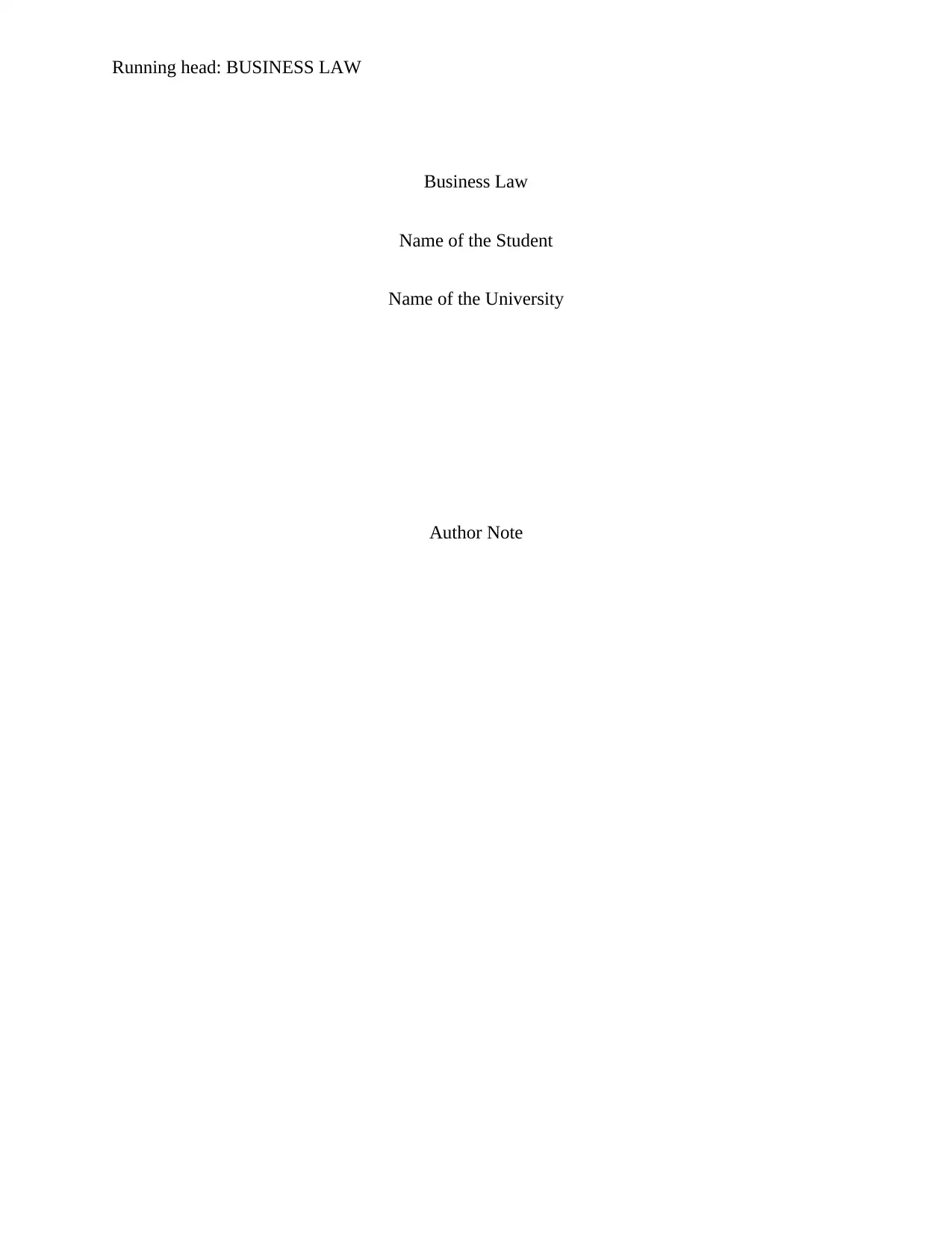
Running head: BUSINESS LAW
Business Law
Name of the Student
Name of the University
Author Note
Business Law
Name of the Student
Name of the University
Author Note
Paraphrase This Document
Need a fresh take? Get an instant paraphrase of this document with our AI Paraphraser
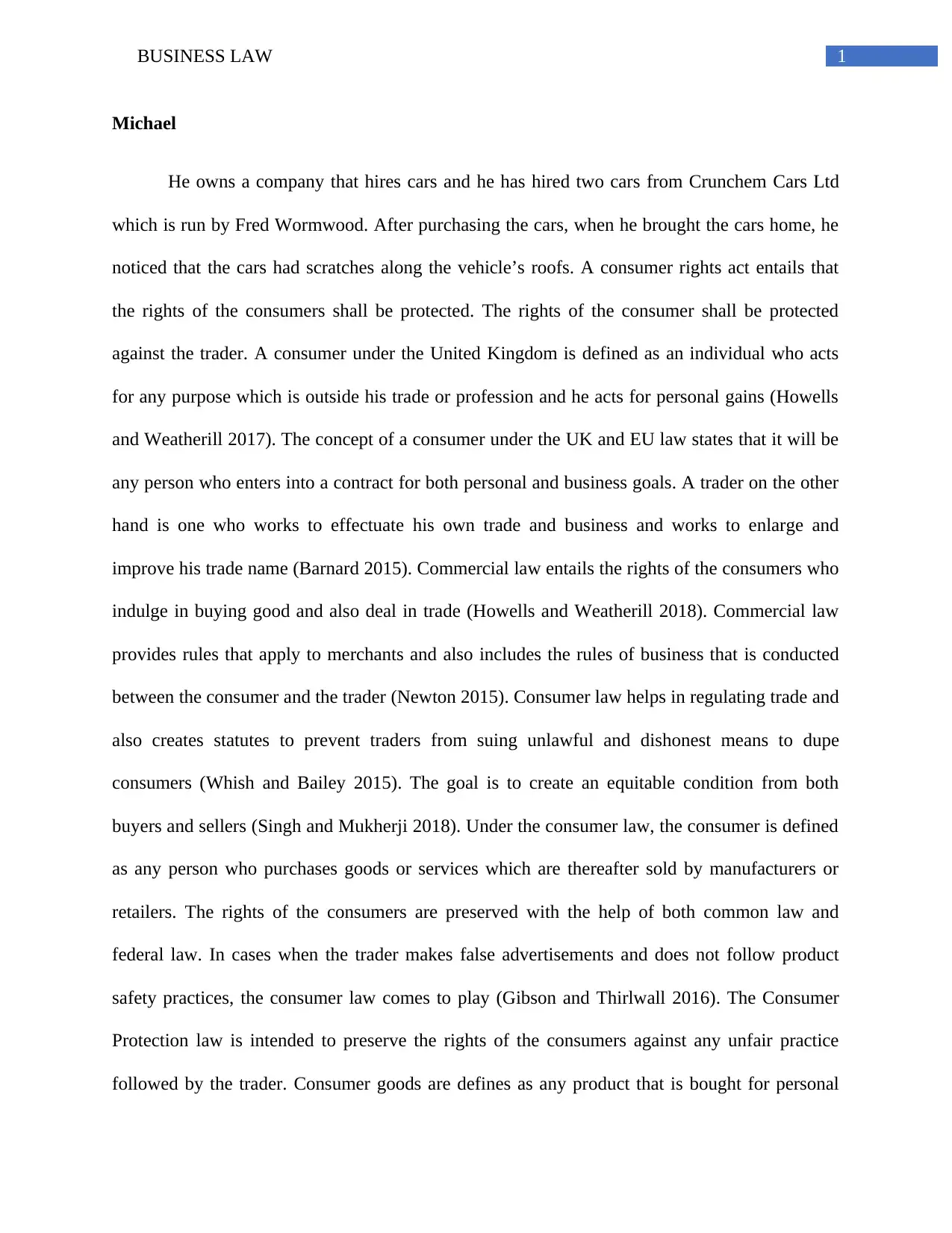
1BUSINESS LAW
Michael
He owns a company that hires cars and he has hired two cars from Crunchem Cars Ltd
which is run by Fred Wormwood. After purchasing the cars, when he brought the cars home, he
noticed that the cars had scratches along the vehicle’s roofs. A consumer rights act entails that
the rights of the consumers shall be protected. The rights of the consumer shall be protected
against the trader. A consumer under the United Kingdom is defined as an individual who acts
for any purpose which is outside his trade or profession and he acts for personal gains (Howells
and Weatherill 2017). The concept of a consumer under the UK and EU law states that it will be
any person who enters into a contract for both personal and business goals. A trader on the other
hand is one who works to effectuate his own trade and business and works to enlarge and
improve his trade name (Barnard 2015). Commercial law entails the rights of the consumers who
indulge in buying good and also deal in trade (Howells and Weatherill 2018). Commercial law
provides rules that apply to merchants and also includes the rules of business that is conducted
between the consumer and the trader (Newton 2015). Consumer law helps in regulating trade and
also creates statutes to prevent traders from suing unlawful and dishonest means to dupe
consumers (Whish and Bailey 2015). The goal is to create an equitable condition from both
buyers and sellers (Singh and Mukherji 2018). Under the consumer law, the consumer is defined
as any person who purchases goods or services which are thereafter sold by manufacturers or
retailers. The rights of the consumers are preserved with the help of both common law and
federal law. In cases when the trader makes false advertisements and does not follow product
safety practices, the consumer law comes to play (Gibson and Thirlwall 2016). The Consumer
Protection law is intended to preserve the rights of the consumers against any unfair practice
followed by the trader. Consumer goods are defines as any product that is bought for personal
Michael
He owns a company that hires cars and he has hired two cars from Crunchem Cars Ltd
which is run by Fred Wormwood. After purchasing the cars, when he brought the cars home, he
noticed that the cars had scratches along the vehicle’s roofs. A consumer rights act entails that
the rights of the consumers shall be protected. The rights of the consumer shall be protected
against the trader. A consumer under the United Kingdom is defined as an individual who acts
for any purpose which is outside his trade or profession and he acts for personal gains (Howells
and Weatherill 2017). The concept of a consumer under the UK and EU law states that it will be
any person who enters into a contract for both personal and business goals. A trader on the other
hand is one who works to effectuate his own trade and business and works to enlarge and
improve his trade name (Barnard 2015). Commercial law entails the rights of the consumers who
indulge in buying good and also deal in trade (Howells and Weatherill 2018). Commercial law
provides rules that apply to merchants and also includes the rules of business that is conducted
between the consumer and the trader (Newton 2015). Consumer law helps in regulating trade and
also creates statutes to prevent traders from suing unlawful and dishonest means to dupe
consumers (Whish and Bailey 2015). The goal is to create an equitable condition from both
buyers and sellers (Singh and Mukherji 2018). Under the consumer law, the consumer is defined
as any person who purchases goods or services which are thereafter sold by manufacturers or
retailers. The rights of the consumers are preserved with the help of both common law and
federal law. In cases when the trader makes false advertisements and does not follow product
safety practices, the consumer law comes to play (Gibson and Thirlwall 2016). The Consumer
Protection law is intended to preserve the rights of the consumers against any unfair practice
followed by the trader. Consumer goods are defines as any product that is bought for personal
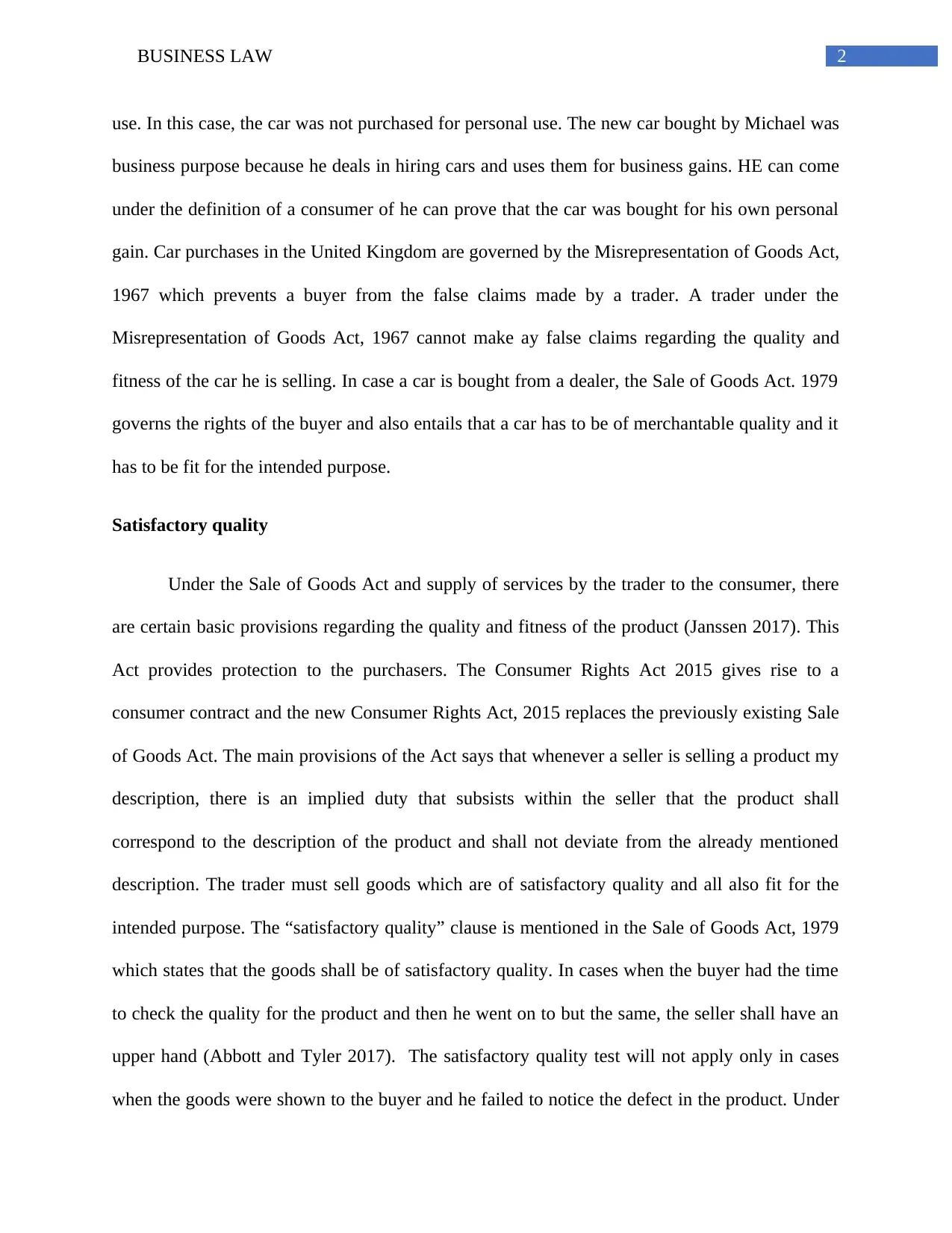
2BUSINESS LAW
use. In this case, the car was not purchased for personal use. The new car bought by Michael was
business purpose because he deals in hiring cars and uses them for business gains. HE can come
under the definition of a consumer of he can prove that the car was bought for his own personal
gain. Car purchases in the United Kingdom are governed by the Misrepresentation of Goods Act,
1967 which prevents a buyer from the false claims made by a trader. A trader under the
Misrepresentation of Goods Act, 1967 cannot make ay false claims regarding the quality and
fitness of the car he is selling. In case a car is bought from a dealer, the Sale of Goods Act. 1979
governs the rights of the buyer and also entails that a car has to be of merchantable quality and it
has to be fit for the intended purpose.
Satisfactory quality
Under the Sale of Goods Act and supply of services by the trader to the consumer, there
are certain basic provisions regarding the quality and fitness of the product (Janssen 2017). This
Act provides protection to the purchasers. The Consumer Rights Act 2015 gives rise to a
consumer contract and the new Consumer Rights Act, 2015 replaces the previously existing Sale
of Goods Act. The main provisions of the Act says that whenever a seller is selling a product my
description, there is an implied duty that subsists within the seller that the product shall
correspond to the description of the product and shall not deviate from the already mentioned
description. The trader must sell goods which are of satisfactory quality and all also fit for the
intended purpose. The “satisfactory quality” clause is mentioned in the Sale of Goods Act, 1979
which states that the goods shall be of satisfactory quality. In cases when the buyer had the time
to check the quality for the product and then he went on to but the same, the seller shall have an
upper hand (Abbott and Tyler 2017). The satisfactory quality test will not apply only in cases
when the goods were shown to the buyer and he failed to notice the defect in the product. Under
use. In this case, the car was not purchased for personal use. The new car bought by Michael was
business purpose because he deals in hiring cars and uses them for business gains. HE can come
under the definition of a consumer of he can prove that the car was bought for his own personal
gain. Car purchases in the United Kingdom are governed by the Misrepresentation of Goods Act,
1967 which prevents a buyer from the false claims made by a trader. A trader under the
Misrepresentation of Goods Act, 1967 cannot make ay false claims regarding the quality and
fitness of the car he is selling. In case a car is bought from a dealer, the Sale of Goods Act. 1979
governs the rights of the buyer and also entails that a car has to be of merchantable quality and it
has to be fit for the intended purpose.
Satisfactory quality
Under the Sale of Goods Act and supply of services by the trader to the consumer, there
are certain basic provisions regarding the quality and fitness of the product (Janssen 2017). This
Act provides protection to the purchasers. The Consumer Rights Act 2015 gives rise to a
consumer contract and the new Consumer Rights Act, 2015 replaces the previously existing Sale
of Goods Act. The main provisions of the Act says that whenever a seller is selling a product my
description, there is an implied duty that subsists within the seller that the product shall
correspond to the description of the product and shall not deviate from the already mentioned
description. The trader must sell goods which are of satisfactory quality and all also fit for the
intended purpose. The “satisfactory quality” clause is mentioned in the Sale of Goods Act, 1979
which states that the goods shall be of satisfactory quality. In cases when the buyer had the time
to check the quality for the product and then he went on to but the same, the seller shall have an
upper hand (Abbott and Tyler 2017). The satisfactory quality test will not apply only in cases
when the goods were shown to the buyer and he failed to notice the defect in the product. Under
⊘ This is a preview!⊘
Do you want full access?
Subscribe today to unlock all pages.

Trusted by 1+ million students worldwide
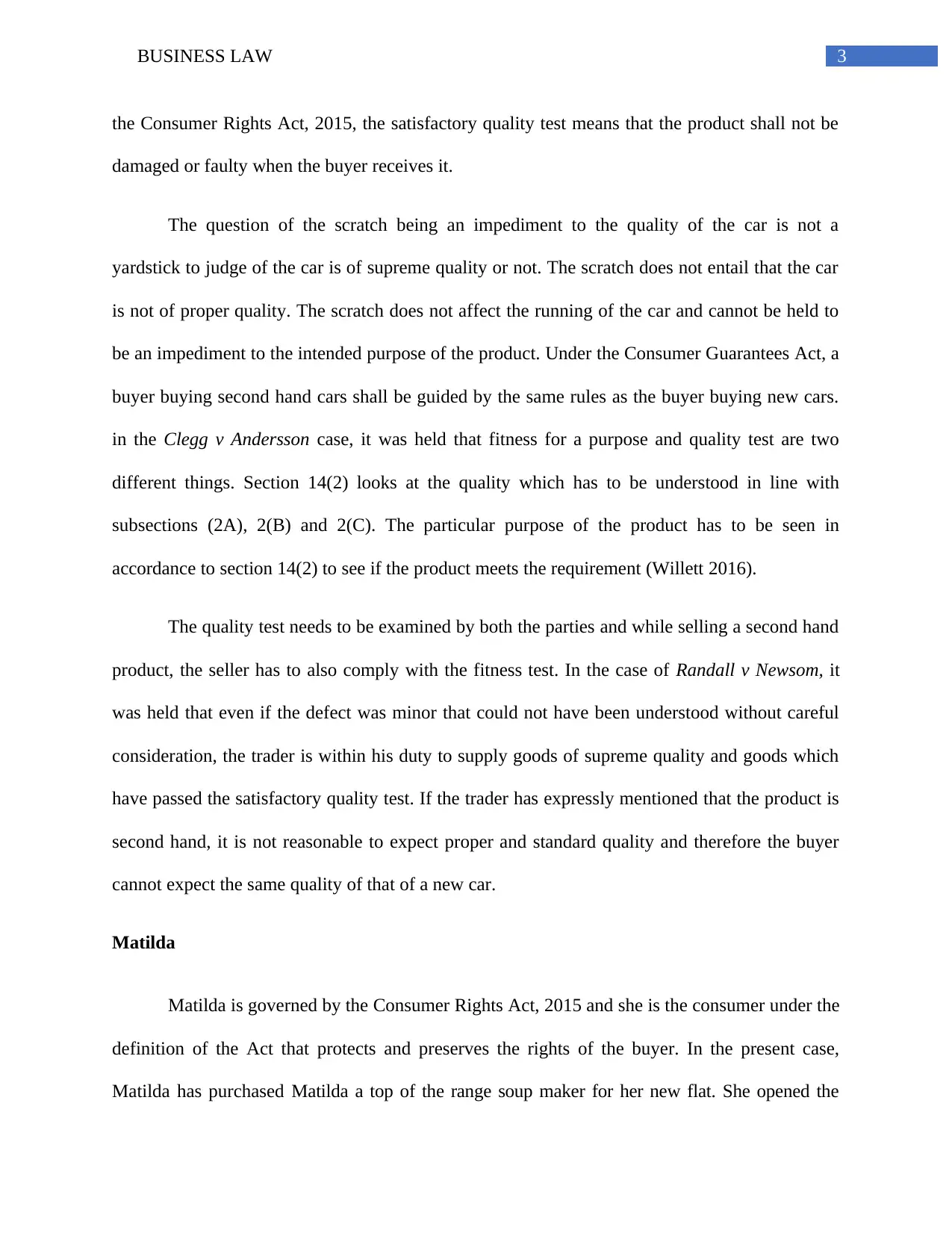
3BUSINESS LAW
the Consumer Rights Act, 2015, the satisfactory quality test means that the product shall not be
damaged or faulty when the buyer receives it.
The question of the scratch being an impediment to the quality of the car is not a
yardstick to judge of the car is of supreme quality or not. The scratch does not entail that the car
is not of proper quality. The scratch does not affect the running of the car and cannot be held to
be an impediment to the intended purpose of the product. Under the Consumer Guarantees Act, a
buyer buying second hand cars shall be guided by the same rules as the buyer buying new cars.
in the Clegg v Andersson case, it was held that fitness for a purpose and quality test are two
different things. Section 14(2) looks at the quality which has to be understood in line with
subsections (2A), 2(B) and 2(C). The particular purpose of the product has to be seen in
accordance to section 14(2) to see if the product meets the requirement (Willett 2016).
The quality test needs to be examined by both the parties and while selling a second hand
product, the seller has to also comply with the fitness test. In the case of Randall v Newsom, it
was held that even if the defect was minor that could not have been understood without careful
consideration, the trader is within his duty to supply goods of supreme quality and goods which
have passed the satisfactory quality test. If the trader has expressly mentioned that the product is
second hand, it is not reasonable to expect proper and standard quality and therefore the buyer
cannot expect the same quality of that of a new car.
Matilda
Matilda is governed by the Consumer Rights Act, 2015 and she is the consumer under the
definition of the Act that protects and preserves the rights of the buyer. In the present case,
Matilda has purchased Matilda a top of the range soup maker for her new flat. She opened the
the Consumer Rights Act, 2015, the satisfactory quality test means that the product shall not be
damaged or faulty when the buyer receives it.
The question of the scratch being an impediment to the quality of the car is not a
yardstick to judge of the car is of supreme quality or not. The scratch does not entail that the car
is not of proper quality. The scratch does not affect the running of the car and cannot be held to
be an impediment to the intended purpose of the product. Under the Consumer Guarantees Act, a
buyer buying second hand cars shall be guided by the same rules as the buyer buying new cars.
in the Clegg v Andersson case, it was held that fitness for a purpose and quality test are two
different things. Section 14(2) looks at the quality which has to be understood in line with
subsections (2A), 2(B) and 2(C). The particular purpose of the product has to be seen in
accordance to section 14(2) to see if the product meets the requirement (Willett 2016).
The quality test needs to be examined by both the parties and while selling a second hand
product, the seller has to also comply with the fitness test. In the case of Randall v Newsom, it
was held that even if the defect was minor that could not have been understood without careful
consideration, the trader is within his duty to supply goods of supreme quality and goods which
have passed the satisfactory quality test. If the trader has expressly mentioned that the product is
second hand, it is not reasonable to expect proper and standard quality and therefore the buyer
cannot expect the same quality of that of a new car.
Matilda
Matilda is governed by the Consumer Rights Act, 2015 and she is the consumer under the
definition of the Act that protects and preserves the rights of the buyer. In the present case,
Matilda has purchased Matilda a top of the range soup maker for her new flat. She opened the
Paraphrase This Document
Need a fresh take? Get an instant paraphrase of this document with our AI Paraphraser
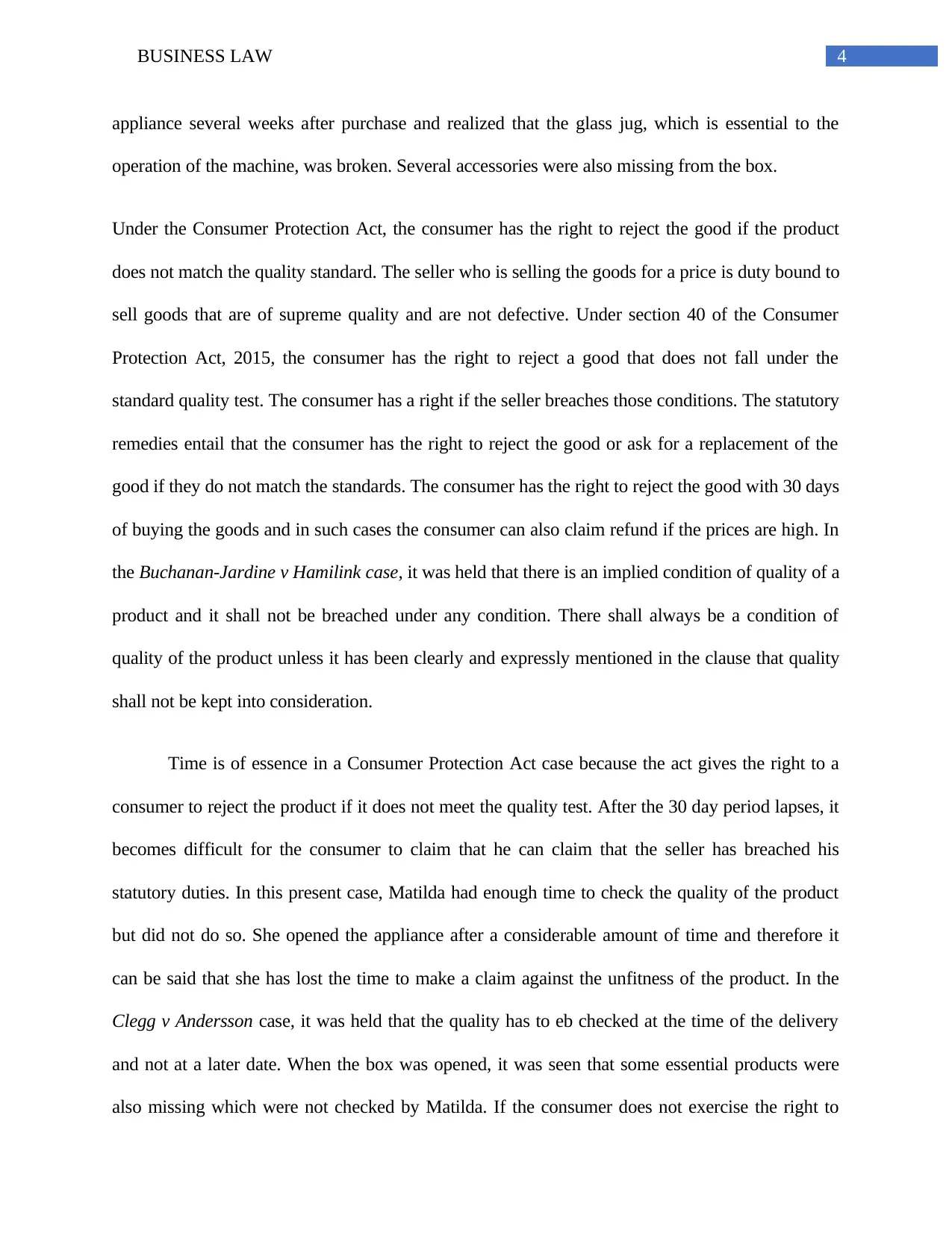
4BUSINESS LAW
appliance several weeks after purchase and realized that the glass jug, which is essential to the
operation of the machine, was broken. Several accessories were also missing from the box.
Under the Consumer Protection Act, the consumer has the right to reject the good if the product
does not match the quality standard. The seller who is selling the goods for a price is duty bound to
sell goods that are of supreme quality and are not defective. Under section 40 of the Consumer
Protection Act, 2015, the consumer has the right to reject a good that does not fall under the
standard quality test. The consumer has a right if the seller breaches those conditions. The statutory
remedies entail that the consumer has the right to reject the good or ask for a replacement of the
good if they do not match the standards. The consumer has the right to reject the good with 30 days
of buying the goods and in such cases the consumer can also claim refund if the prices are high. In
the Buchanan-Jardine v Hamilink case, it was held that there is an implied condition of quality of a
product and it shall not be breached under any condition. There shall always be a condition of
quality of the product unless it has been clearly and expressly mentioned in the clause that quality
shall not be kept into consideration.
Time is of essence in a Consumer Protection Act case because the act gives the right to a
consumer to reject the product if it does not meet the quality test. After the 30 day period lapses, it
becomes difficult for the consumer to claim that he can claim that the seller has breached his
statutory duties. In this present case, Matilda had enough time to check the quality of the product
but did not do so. She opened the appliance after a considerable amount of time and therefore it
can be said that she has lost the time to make a claim against the unfitness of the product. In the
Clegg v Andersson case, it was held that the quality has to eb checked at the time of the delivery
and not at a later date. When the box was opened, it was seen that some essential products were
also missing which were not checked by Matilda. If the consumer does not exercise the right to
appliance several weeks after purchase and realized that the glass jug, which is essential to the
operation of the machine, was broken. Several accessories were also missing from the box.
Under the Consumer Protection Act, the consumer has the right to reject the good if the product
does not match the quality standard. The seller who is selling the goods for a price is duty bound to
sell goods that are of supreme quality and are not defective. Under section 40 of the Consumer
Protection Act, 2015, the consumer has the right to reject a good that does not fall under the
standard quality test. The consumer has a right if the seller breaches those conditions. The statutory
remedies entail that the consumer has the right to reject the good or ask for a replacement of the
good if they do not match the standards. The consumer has the right to reject the good with 30 days
of buying the goods and in such cases the consumer can also claim refund if the prices are high. In
the Buchanan-Jardine v Hamilink case, it was held that there is an implied condition of quality of a
product and it shall not be breached under any condition. There shall always be a condition of
quality of the product unless it has been clearly and expressly mentioned in the clause that quality
shall not be kept into consideration.
Time is of essence in a Consumer Protection Act case because the act gives the right to a
consumer to reject the product if it does not meet the quality test. After the 30 day period lapses, it
becomes difficult for the consumer to claim that he can claim that the seller has breached his
statutory duties. In this present case, Matilda had enough time to check the quality of the product
but did not do so. She opened the appliance after a considerable amount of time and therefore it
can be said that she has lost the time to make a claim against the unfitness of the product. In the
Clegg v Andersson case, it was held that the quality has to eb checked at the time of the delivery
and not at a later date. When the box was opened, it was seen that some essential products were
also missing which were not checked by Matilda. If the consumer does not exercise the right to
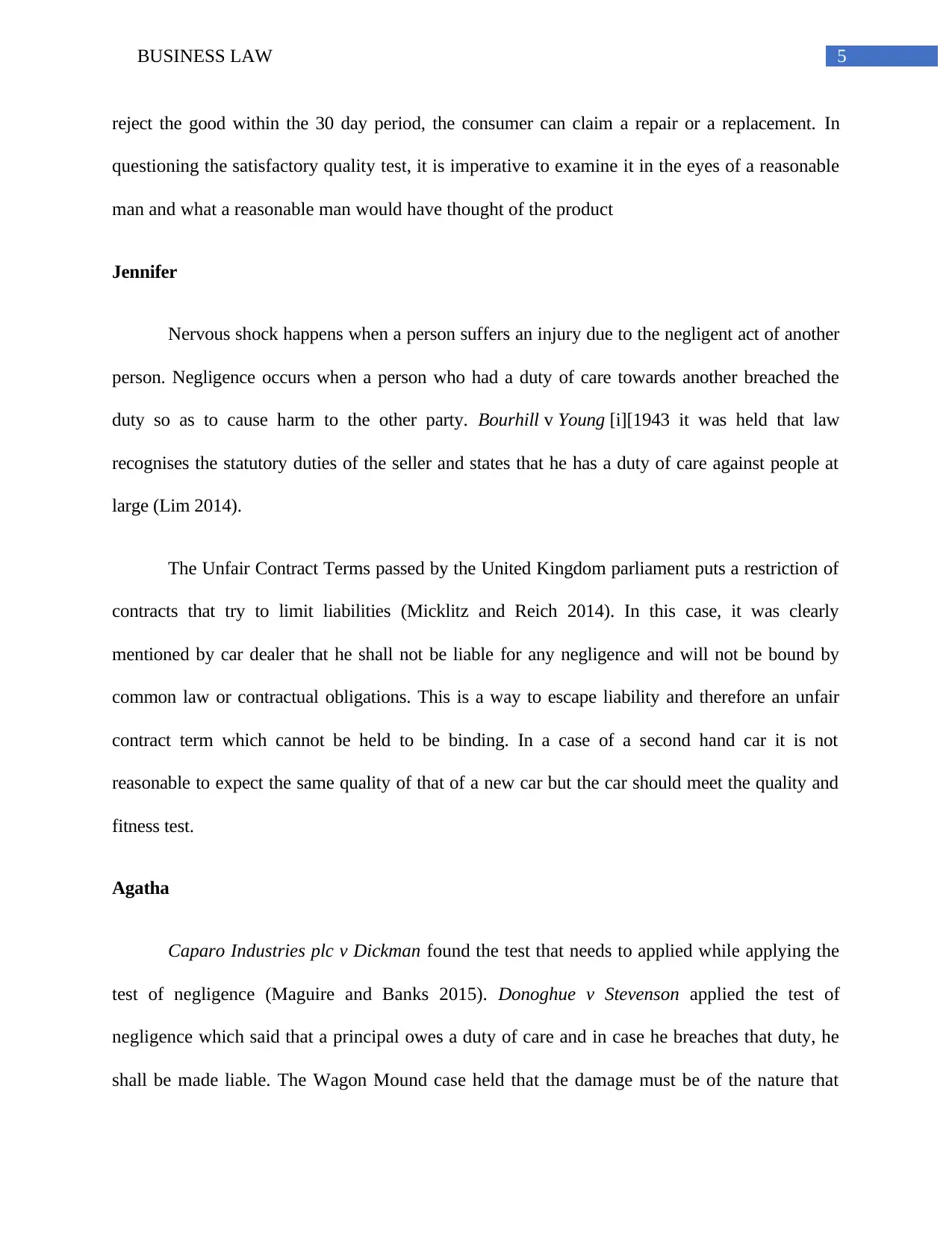
5BUSINESS LAW
reject the good within the 30 day period, the consumer can claim a repair or a replacement. In
questioning the satisfactory quality test, it is imperative to examine it in the eyes of a reasonable
man and what a reasonable man would have thought of the product
Jennifer
Nervous shock happens when a person suffers an injury due to the negligent act of another
person. Negligence occurs when a person who had a duty of care towards another breached the
duty so as to cause harm to the other party. Bourhill v Young [i][1943 it was held that law
recognises the statutory duties of the seller and states that he has a duty of care against people at
large (Lim 2014).
The Unfair Contract Terms passed by the United Kingdom parliament puts a restriction of
contracts that try to limit liabilities (Micklitz and Reich 2014). In this case, it was clearly
mentioned by car dealer that he shall not be liable for any negligence and will not be bound by
common law or contractual obligations. This is a way to escape liability and therefore an unfair
contract term which cannot be held to be binding. In a case of a second hand car it is not
reasonable to expect the same quality of that of a new car but the car should meet the quality and
fitness test.
Agatha
Caparo Industries plc v Dickman found the test that needs to applied while applying the
test of negligence (Maguire and Banks 2015). Donoghue v Stevenson applied the test of
negligence which said that a principal owes a duty of care and in case he breaches that duty, he
shall be made liable. The Wagon Mound case held that the damage must be of the nature that
reject the good within the 30 day period, the consumer can claim a repair or a replacement. In
questioning the satisfactory quality test, it is imperative to examine it in the eyes of a reasonable
man and what a reasonable man would have thought of the product
Jennifer
Nervous shock happens when a person suffers an injury due to the negligent act of another
person. Negligence occurs when a person who had a duty of care towards another breached the
duty so as to cause harm to the other party. Bourhill v Young [i][1943 it was held that law
recognises the statutory duties of the seller and states that he has a duty of care against people at
large (Lim 2014).
The Unfair Contract Terms passed by the United Kingdom parliament puts a restriction of
contracts that try to limit liabilities (Micklitz and Reich 2014). In this case, it was clearly
mentioned by car dealer that he shall not be liable for any negligence and will not be bound by
common law or contractual obligations. This is a way to escape liability and therefore an unfair
contract term which cannot be held to be binding. In a case of a second hand car it is not
reasonable to expect the same quality of that of a new car but the car should meet the quality and
fitness test.
Agatha
Caparo Industries plc v Dickman found the test that needs to applied while applying the
test of negligence (Maguire and Banks 2015). Donoghue v Stevenson applied the test of
negligence which said that a principal owes a duty of care and in case he breaches that duty, he
shall be made liable. The Wagon Mound case held that the damage must be of the nature that
⊘ This is a preview!⊘
Do you want full access?
Subscribe today to unlock all pages.

Trusted by 1+ million students worldwide
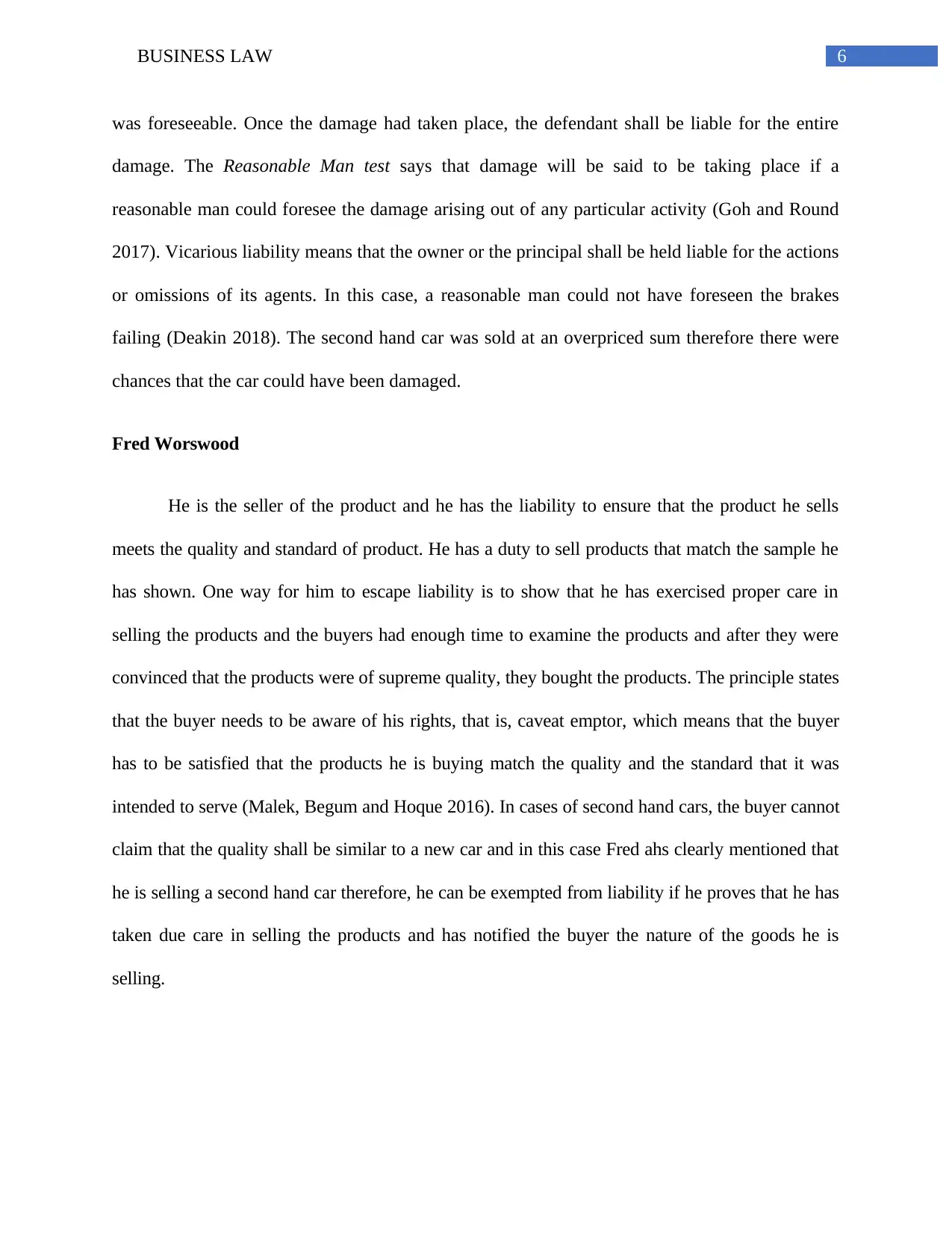
6BUSINESS LAW
was foreseeable. Once the damage had taken place, the defendant shall be liable for the entire
damage. The Reasonable Man test says that damage will be said to be taking place if a
reasonable man could foresee the damage arising out of any particular activity (Goh and Round
2017). Vicarious liability means that the owner or the principal shall be held liable for the actions
or omissions of its agents. In this case, a reasonable man could not have foreseen the brakes
failing (Deakin 2018). The second hand car was sold at an overpriced sum therefore there were
chances that the car could have been damaged.
Fred Worswood
He is the seller of the product and he has the liability to ensure that the product he sells
meets the quality and standard of product. He has a duty to sell products that match the sample he
has shown. One way for him to escape liability is to show that he has exercised proper care in
selling the products and the buyers had enough time to examine the products and after they were
convinced that the products were of supreme quality, they bought the products. The principle states
that the buyer needs to be aware of his rights, that is, caveat emptor, which means that the buyer
has to be satisfied that the products he is buying match the quality and the standard that it was
intended to serve (Malek, Begum and Hoque 2016). In cases of second hand cars, the buyer cannot
claim that the quality shall be similar to a new car and in this case Fred ahs clearly mentioned that
he is selling a second hand car therefore, he can be exempted from liability if he proves that he has
taken due care in selling the products and has notified the buyer the nature of the goods he is
selling.
was foreseeable. Once the damage had taken place, the defendant shall be liable for the entire
damage. The Reasonable Man test says that damage will be said to be taking place if a
reasonable man could foresee the damage arising out of any particular activity (Goh and Round
2017). Vicarious liability means that the owner or the principal shall be held liable for the actions
or omissions of its agents. In this case, a reasonable man could not have foreseen the brakes
failing (Deakin 2018). The second hand car was sold at an overpriced sum therefore there were
chances that the car could have been damaged.
Fred Worswood
He is the seller of the product and he has the liability to ensure that the product he sells
meets the quality and standard of product. He has a duty to sell products that match the sample he
has shown. One way for him to escape liability is to show that he has exercised proper care in
selling the products and the buyers had enough time to examine the products and after they were
convinced that the products were of supreme quality, they bought the products. The principle states
that the buyer needs to be aware of his rights, that is, caveat emptor, which means that the buyer
has to be satisfied that the products he is buying match the quality and the standard that it was
intended to serve (Malek, Begum and Hoque 2016). In cases of second hand cars, the buyer cannot
claim that the quality shall be similar to a new car and in this case Fred ahs clearly mentioned that
he is selling a second hand car therefore, he can be exempted from liability if he proves that he has
taken due care in selling the products and has notified the buyer the nature of the goods he is
selling.
Paraphrase This Document
Need a fresh take? Get an instant paraphrase of this document with our AI Paraphraser
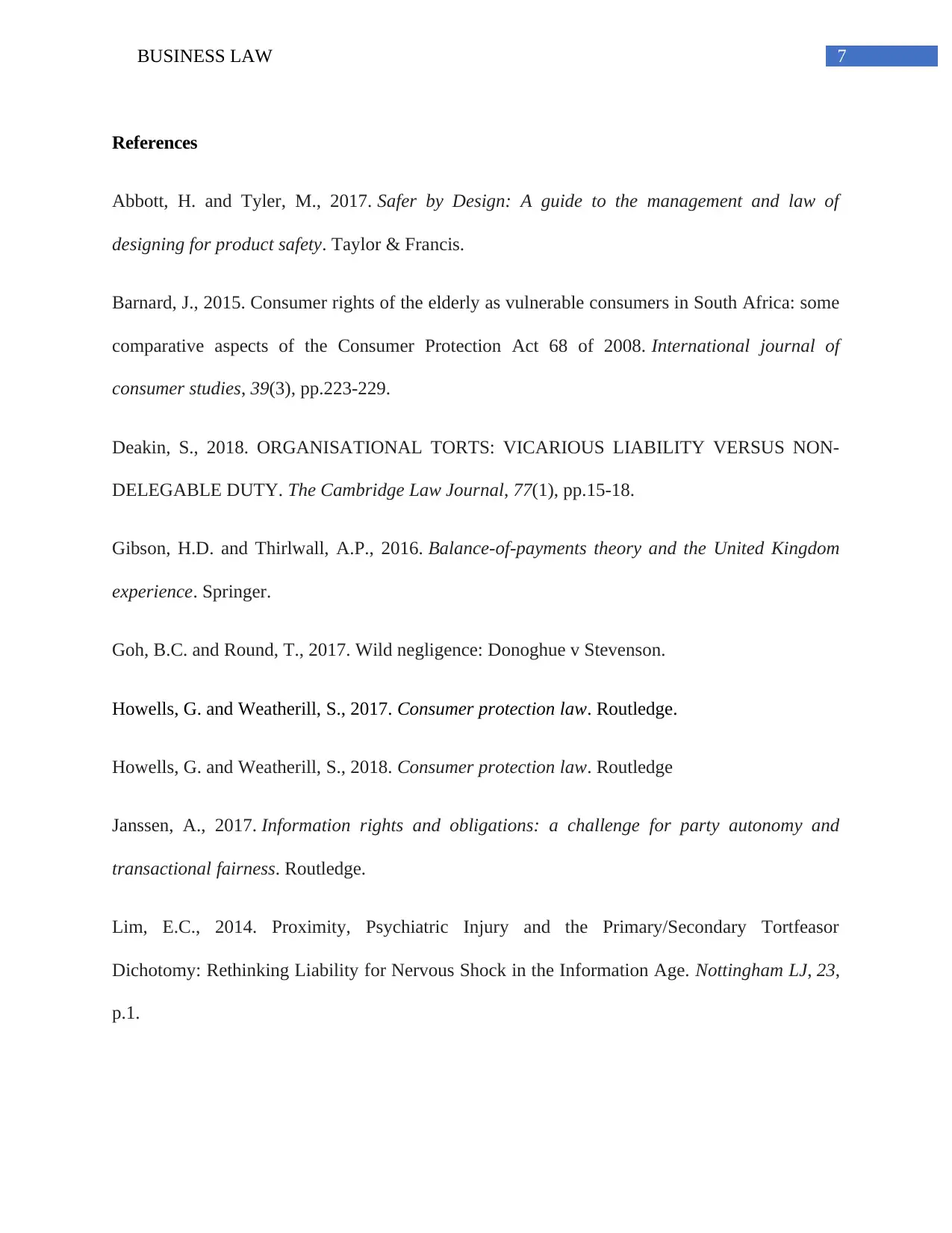
7BUSINESS LAW
References
Abbott, H. and Tyler, M., 2017. Safer by Design: A guide to the management and law of
designing for product safety. Taylor & Francis.
Barnard, J., 2015. Consumer rights of the elderly as vulnerable consumers in South Africa: some
comparative aspects of the Consumer Protection Act 68 of 2008. International journal of
consumer studies, 39(3), pp.223-229.
Deakin, S., 2018. ORGANISATIONAL TORTS: VICARIOUS LIABILITY VERSUS NON-
DELEGABLE DUTY. The Cambridge Law Journal, 77(1), pp.15-18.
Gibson, H.D. and Thirlwall, A.P., 2016. Balance-of-payments theory and the United Kingdom
experience. Springer.
Goh, B.C. and Round, T., 2017. Wild negligence: Donoghue v Stevenson.
Howells, G. and Weatherill, S., 2017. Consumer protection law. Routledge.
Howells, G. and Weatherill, S., 2018. Consumer protection law. Routledge
Janssen, A., 2017. Information rights and obligations: a challenge for party autonomy and
transactional fairness. Routledge.
Lim, E.C., 2014. Proximity, Psychiatric Injury and the Primary/Secondary Tortfeasor
Dichotomy: Rethinking Liability for Nervous Shock in the Information Age. Nottingham LJ, 23,
p.1.
References
Abbott, H. and Tyler, M., 2017. Safer by Design: A guide to the management and law of
designing for product safety. Taylor & Francis.
Barnard, J., 2015. Consumer rights of the elderly as vulnerable consumers in South Africa: some
comparative aspects of the Consumer Protection Act 68 of 2008. International journal of
consumer studies, 39(3), pp.223-229.
Deakin, S., 2018. ORGANISATIONAL TORTS: VICARIOUS LIABILITY VERSUS NON-
DELEGABLE DUTY. The Cambridge Law Journal, 77(1), pp.15-18.
Gibson, H.D. and Thirlwall, A.P., 2016. Balance-of-payments theory and the United Kingdom
experience. Springer.
Goh, B.C. and Round, T., 2017. Wild negligence: Donoghue v Stevenson.
Howells, G. and Weatherill, S., 2017. Consumer protection law. Routledge.
Howells, G. and Weatherill, S., 2018. Consumer protection law. Routledge
Janssen, A., 2017. Information rights and obligations: a challenge for party autonomy and
transactional fairness. Routledge.
Lim, E.C., 2014. Proximity, Psychiatric Injury and the Primary/Secondary Tortfeasor
Dichotomy: Rethinking Liability for Nervous Shock in the Information Age. Nottingham LJ, 23,
p.1.
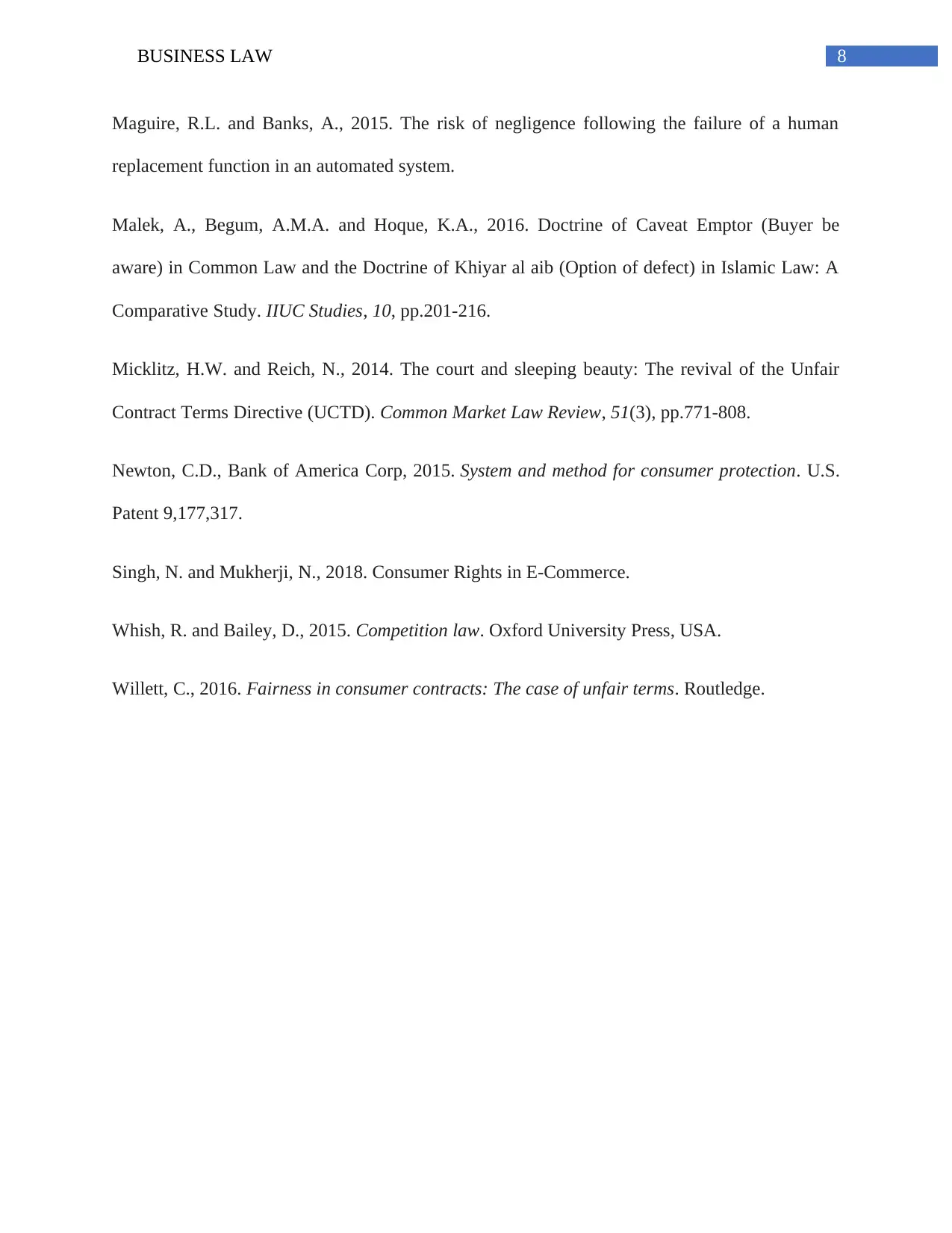
8BUSINESS LAW
Maguire, R.L. and Banks, A., 2015. The risk of negligence following the failure of a human
replacement function in an automated system.
Malek, A., Begum, A.M.A. and Hoque, K.A., 2016. Doctrine of Caveat Emptor (Buyer be
aware) in Common Law and the Doctrine of Khiyar al aib (Option of defect) in Islamic Law: A
Comparative Study. IIUC Studies, 10, pp.201-216.
Micklitz, H.W. and Reich, N., 2014. The court and sleeping beauty: The revival of the Unfair
Contract Terms Directive (UCTD). Common Market Law Review, 51(3), pp.771-808.
Newton, C.D., Bank of America Corp, 2015. System and method for consumer protection. U.S.
Patent 9,177,317.
Singh, N. and Mukherji, N., 2018. Consumer Rights in E-Commerce.
Whish, R. and Bailey, D., 2015. Competition law. Oxford University Press, USA.
Willett, C., 2016. Fairness in consumer contracts: The case of unfair terms. Routledge.
Maguire, R.L. and Banks, A., 2015. The risk of negligence following the failure of a human
replacement function in an automated system.
Malek, A., Begum, A.M.A. and Hoque, K.A., 2016. Doctrine of Caveat Emptor (Buyer be
aware) in Common Law and the Doctrine of Khiyar al aib (Option of defect) in Islamic Law: A
Comparative Study. IIUC Studies, 10, pp.201-216.
Micklitz, H.W. and Reich, N., 2014. The court and sleeping beauty: The revival of the Unfair
Contract Terms Directive (UCTD). Common Market Law Review, 51(3), pp.771-808.
Newton, C.D., Bank of America Corp, 2015. System and method for consumer protection. U.S.
Patent 9,177,317.
Singh, N. and Mukherji, N., 2018. Consumer Rights in E-Commerce.
Whish, R. and Bailey, D., 2015. Competition law. Oxford University Press, USA.
Willett, C., 2016. Fairness in consumer contracts: The case of unfair terms. Routledge.
⊘ This is a preview!⊘
Do you want full access?
Subscribe today to unlock all pages.

Trusted by 1+ million students worldwide
1 out of 9
Related Documents
Your All-in-One AI-Powered Toolkit for Academic Success.
+13062052269
info@desklib.com
Available 24*7 on WhatsApp / Email
![[object Object]](/_next/static/media/star-bottom.7253800d.svg)
Unlock your academic potential
Copyright © 2020–2025 A2Z Services. All Rights Reserved. Developed and managed by ZUCOL.




